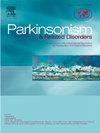Defining ‘OFF’ time in device-aided therapy criteria for Parkinson’s disease: gaps and opportunities
IF 3.4
3区 医学
Q2 CLINICAL NEUROLOGY
引用次数: 0
Abstract
Evaluating individuals with Parkinson's to determine if they have progressed to the advanced stage and may be suitable for transitioning from intermittent oral medications to continuous, device-aided therapy (DAT) involves considering multiple clinical factors. A key parameter in this assessment, and an indicator of a declining response to oral medication, is overall daily OFF time and the occurrence of unpredictable OFF episodes. OFF-periods are, however, complex and experienced differently by individual patients, so assessment of duration alone may not provide an accurate picture of the patient's lived experience and the challenges they face, information which can be helpful in deciding appropriate management. A range of useful screening tools are available to assist clinicians in determining if a patient has advanced disease and may be suitable for DAT, but these do not always capture the aspects of OFF periods that are the most important, or the most bothersome, to patients. To improve recognition, enhance patient-clinician communication, and achieve effective, personalized management of OFF periods, we propose expanding these tools to consider additional dimensions in three specific areas. First, incorporate patient insights into the personal and functional impact, including the severity of OFF periods, effects on daily activities, and the types and timing (daytime or nighttime) of episodes. Second, include specialist advice from clinicians to characterise the nature of these symptoms and determine suitable therapies. Finally, support this with objective information from PD diaries or technology-based monitoring.
在帕金森病的设备辅助治疗标准中定义“关闭”时间:差距和机遇
评估帕金森患者以确定他们是否已经进展到晚期,是否适合从间歇性口服药物过渡到持续的器械辅助治疗(DAT)需要考虑多个临床因素。这项评估的一个关键参数,以及对口服药物反应下降的一个指标,是总的每日OFF时间和不可预测的OFF发作的发生。然而,off -period是复杂的,每个患者的经历也不同,因此单独评估持续时间可能无法准确描述患者的生活经历和他们面临的挑战,这些信息可能有助于决定适当的管理。有一系列有用的筛查工具可以帮助临床医生确定患者是否患有晚期疾病,是否适合进行DAT,但这些工具并不总是能捕捉到OFF期对患者最重要或最麻烦的方面。为了提高对OFF期的认识,加强医患沟通,实现有效、个性化的管理,我们建议扩展这些工具,在三个特定领域考虑额外的维度。首先,结合患者对个人和功能影响的见解,包括OFF期的严重程度,对日常活动的影响,以及发作的类型和时间(白天或夜间)。其次,包括临床医生的专家建议,以描述这些症状的性质并确定合适的治疗方法。最后,用PD日记或基于技术的监测的客观信息来支持这一点。
本文章由计算机程序翻译,如有差异,请以英文原文为准。
求助全文
约1分钟内获得全文
求助全文
来源期刊

Parkinsonism & related disorders
医学-临床神经学
CiteScore
6.20
自引率
4.90%
发文量
292
审稿时长
39 days
期刊介绍:
Parkinsonism & Related Disorders publishes the results of basic and clinical research contributing to the understanding, diagnosis and treatment of all neurodegenerative syndromes in which Parkinsonism, Essential Tremor or related movement disorders may be a feature. Regular features will include: Review Articles, Point of View articles, Full-length Articles, Short Communications, Case Reports and Letter to the Editor.
 求助内容:
求助内容: 应助结果提醒方式:
应助结果提醒方式:


